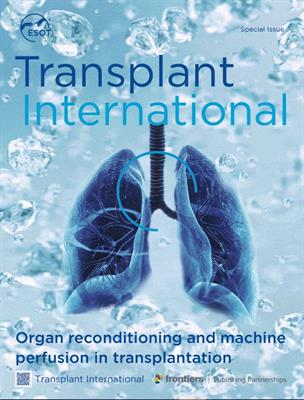Transplant International dedicates the Special Issue on Organ Reconditioning and Machine Perfusion in Transplantation to Professor Paolo Muiesan, as a tribute to his career accomplishments in the field of dynamic organ preservation. Ciao Paolo, you are gone far too soon, but you will never be forgotten!
Transplantation is the only curative treatment option for end-stage organ disease; however, its use remains limited due to a shortage of suitable organs. Thus, the use of extended criteria donors, where dynamic preservation strategies promise to be key for successful outcomes, particularly limiting ischemic injury following organ retrieval. Given the variety of combinations of different parameters and settings (temperature, oxygen, nutrient and/or drug delivery, in situ/ex-situ), machine perfusion promises to increase organ viability assessment prior to implantation and thus could lead to an additional tool for tailoring each preservation parameter to each different organ, on the basis of the presumed ischemic injury.
This Special Issue will become a state of the art collection on the use of dynamic preservation, in all its forms and modalities, in comparison to the standard static cold storage and in view of the organ donor pool expansion. In particular, it will focus on the possibility for an organ to be reconditioned and repaired via a dynamic platform, where the physician could directly influence the organ status and the cell metabolism, in consideration of the evidence-based approaches that different centers are currently using to optimize organ utilization rates. The pathogenesis of the ischemic injury, its consequences in terms of primary or delayed graft function and early dysfunction for all thoracic and abdominal organs, as well as the long consequences of the different preservation modalities to significantly affect graft and patient survivals will be included, with a view on possible integration with clinical parameters or omics.
This Special Issue aims to highlight the latest research and innovation on machine perfusion in thoracic and abdominal organ transplantation to increase awareness about this underutilized resource, in consideration of the scarcity of suitable organ donors and to potentially achieve waitlist self-sufficiency. We encourage submissions related to viability assessment, logistical and technical aspects, cost-effectiveness, immunological effects, combined modalities, and long-term outcomes. Original articles based on clinical experience are welcome; likewise, we hope to attract review articles that describe the current state of the art.
Potential topics include, but are not limited to, the following:
· Ischemia-reperfusion injury and viability assessment
· Hypothermic machine perfusion
· Normothermic machine perfusion
· Normothermic regional perfusion
· Preservation solutions in machine perfusion
· Oxygenation during machine perfusion
· Artificial organs
Keywords: Ischemia-reperfusion injury, Hypothermic machine perfusion, Normothermic machine perfusion, Normothermic regional perfusion, Preservation techniques, Artificial organs







